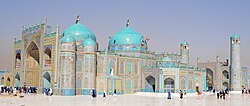 | |
| Total population | |
|---|---|
| 43 [1] 0.0001% of total population (2022) 200,000 - 500,000 (diaspora) [2] [3] [4] [5] [6] | |
| Regions with significant populations | |
| 9,194-75,000 [7] | |
| >10,000 [8] | |
| 2,000 [9] | |
| 43 [1] | |
| Religions | |
| | |
| Languages | |
| Pashto • Dari • Hindko Punjabi • Hindi • Urdu | |
| Part of a series of articles on |
| Religion in Afghanistan |
|---|
 |
| Majority |
| Sunni Islam |
| Minority |
| Historic/Extinct |
| Controversy |

| Part of a series on |
| Sikhism |
|---|
 |

Sikhism inAfghanistan in the contemporary era is limited to small populations, primarily in major cities, with the largest numbers of Afghan Sikhs living in Jalalabad, Ghazni, Kabul, and to a lesser extent in Kandahar and Khost. [10] Sikhs have been the most prevalent non-Muslim minority in Afghanistan, and despite the many political changes in recent Afghan history, governments and political groups have generally not indulged in openly discriminating against the Sikh minority; however, their status have been severely impacted amid the country's conflict since 1978. [11]
Contents
- Presence
- Kabul
- Jalalabad
- Kandahar
- Khost
- History
- Early history
- 20th century
- Wars
- 21st century
- Diaspora
- Notable people
- See also
- Notes
- References
- Further reading
- External links
The origin of the Sikh community in Afghanistan has broadly two streams, including indigenous Pashto and Dari speakers, descendants of converts to the teaching of the Sikhism’s founder Guru Nanak during his trip to Kabul around 1520. [12] The second stream derive from the later Sikh Empire as it pushed westward, establishing trading routes for Sikh merchants into Kandahar and Kabul; this group speak Hindko, a dialect of Punjabi. [12] Due to this mixed ancestry, Afghan Sikhs are from various ethnolinguistic backgrounds including Pashtun, [13] [14] Hindkowan or Punjabi.
Once numbering between 200,000 and 500,000 (1.8% to 4.6% of the national population, making it among the largest of any country at that time) in the 1970s, [2] [3] [4] [5] [6] their population in Afghanistan has dwindled since the Afghan wars began. [15] Estimates of their total population (there has been no census in Afghanistan since 1979) have been given as around 1,200 families or 8,000 members in 2013; [16] 1,000 in 2019 (as reported by Afghan Sikh Wolesi Jirga member Narinder Singh Khalsa); and around 70 to 80 families or 700 in 2020 (as reported by Raj Sutaka, a Sikh businessman from Kabul). [17] Thousands of Afghan Sikhs now live in India, [18] the United Kingdom, [19] the United States, [20] and Canada. [21]


